Table of Contents
Thomas and Lillian's sons
Tom and Lillian had four children, of whom two survived infancy.
Tom
Though we try to avoid biographies of living M-Ps, there are two photographs which are in the public domain. One, from the National Archives of Australia, is a photo of Thomas A. M-P c.1960. It is captioned 'Singapore student, Manoharan Ponnusamy, in special Cuban dress, plays the bongo drums watched by medical students George Wells, left, and Tom Murray-Prior at Queensland University', click on students. The other photo, from the Fryer Library (University of Queensland) Miscellaneous Photograph Collection1) was taken in Brisbane, 1960 and is captioned, 'University of Queensland Inter-College Rowing Champions' with Tom Murray-Prior 3rd from left in 2nd back row. 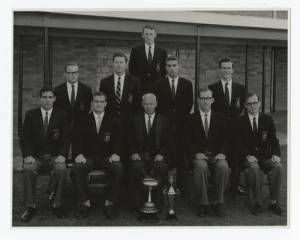
Richard John M-P
Richard John (12 June 1945 - 8 December 2001) was remembered in his eulogy as a 'family member, friend, pilot, prawn spotter, Torres Strait Island trader, and … Palm Island businessman…. an adventurous, kind, swashbuckling and at times crazy kind of bloke …[who could] tell the greatest stories … Always positive, always working hard … People were drawn to him. He was a terrific host, loved his wine and his dinner parties and was an excellent cook'.
This vibrant man was born at his parents' home in Leura in the Blue Mountains.2) As outlined in his parents' entry, when Richard was young the family moved first to Southport then to Bundaberg. When he was around 12 or 13 years old, the family moved to Cairns. Apart from a brief, unhappy period boarding at Brisbane Boys' College, he went to Cairns High School where he excelled at Maths and English.
Richard as a baby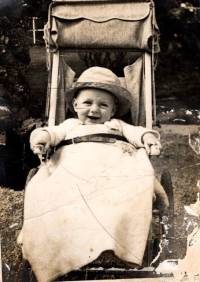 and toddler
and toddler  When a child, he suffered from glomerulonephritis, a disease of the kidneys.
When a child, he suffered from glomerulonephritis, a disease of the kidneys.
Richard M-P with his elder brother: in July 1948, 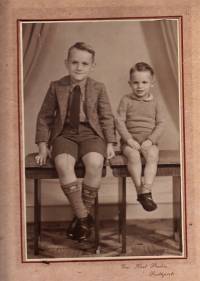 and c.late 1950s.
and c.late 1950s. 
On leaving school, Richard's adventurous spirit saw him going west to become a jackaroo, first on Dotswood Station near Charters Towers. His boss at Dotswood had a profound effect on Richard and they formed a lifelong friendship. He then moved to Warwombie and Wongalee near Hughenden. It was while working there that he met his future wife, Ilma Murphy, then a teacher in Hughenden.
Richard turned 20 in 1965, a year after Australia introduced compulsory national service for 20-year-old males, and the year before conscripts could be sent to fight in the Vietnam War. He was rejected on health grounds as his kidneys were damaged from his childhood illness. He also had an irregular-shaped iris which required him to wear sunglasses in the bright sunshine. At the time he regretted not having the opportunity to experience Army life overseas.
Richard returned to Cairns in the mid-1966 to work in his father’s business. Richard's charismatic personality meant that he was liked by people from all walks of life. One consequence was that he became President of the newly-formed Cairns Businessman’s Club. On 7 January 1967, he and Ilma married. The newly-weds stayed in Cairns, Richard in his father's business and Ilma teaching.
The newly-weds stayed in Cairns, Richard in his father's business and Ilma teaching.
Richard had always had a love of flying. Encouraged by his father and his father's former RAAF compatriots, some of who were still pilots with the local airline Bush Pilots, Richard decided to become a pilot. While Ilma continued teaching, Richard looked after their young son and learnt to fly. He acquired his licence in 1970 and started flying. Ilma’s father was close friends with the manager of Amagraze, a cattle and prawn buying and processing company in Cairns, so he introduced Richard to the manager and, as they say, the rest is history.
Amagraze operated prawn trawlers and they contracted Richard to fly in the Gulf of Carpentaria to find the prawns and notify the trawlers where the ‘prawn boils’ were to be found. A ‘prawn boil’ is a discolouration of the water caused by the prawns emerging from mud. Richard and a friend formed a company, purchased a Twin Comanche long range aircraft, and formed Outback Air. Over the next 28 years, Richard took the skill of finding prawns from a chance operation to a highly-skilled and technical process. He was able, using water temperature, phases of the moon, and previous wet season rain falls to predict where boats should be positioned for optimum catches. Richard was recognised as the best ‘prawn spotter’ in the Gulf. Typical of Richard, he was always happy to try and teach the younger pilots and spotters his skills.
After a few years, Richard and Ilma bought out their partners who were keen to move south. Ilma gave up teaching to take on the day-to-day running of the company. By this time, Outback Air leased five aircraft and had its own engineering set-up. Richard inspired their pilots. This was demonstrated when QANTAS’s recruiting department congratulated him on the fact they employed more pilots from his small family company than any other single charter operation. On the home front, in the mid-1970s, Richard and Ilma had a daughter.
Outback Air was not just about prawns. During these years both Richard and Ilma spent a lot of time travelling to and staying in Aboriginal communities, getting to know the people and studying the culture. When Gough Whitlam was Prime Minister (1972-1975), it was decided to record traditional Indigenous dance. Dance festivals were organised across the top end of Australia. Outback Air was involved in the organisation and provided all the transport for the festivals in the Cape York Peninsula. Richard, Ilma and the recording anthropologists were the only non-indigenous people to witness these dance festivals.
The Royal Flying Doctor Service was another important aspect of Outback Air's work. Richard did a lot of gratis piloting for the Service, sometimes using his own aircraft and at other times flying their aircraft. He saw this as his way of giving back to the outback he loved so much.Outback Air was also frequently chartered to fly contractors and State and Federal politicians to the Torres Straits. More dangerously, Richard became involved with Federal Customs and the Queensland Police in controlling illegal drug importation. This work was in keeping with Richard's strong anti-drug stance. Quite apart from this, flying had its inherent dangers. Three incidents in particular stand out.
One time, just after Richard obtained his private licence, he flew to a cattle station to deliver emergency rations after a cyclone. As he landed, he encountered a roll of fencing wire, blown there by the cyclone, and it wrapped itself around the front of the plane. Nobody had thought to check the landing strip. The next incident was years later when he was returning to Cairns from a charter. It was dark night with a thunderstorm between his position and the Cairns airport. His aircraft lost all its electrics including radios and undercarriage motor. When Richard eventually landed, it was with his wheels up in a blaze of sparks. Given he still had a lot of fuel stored in the auxiliary wing tip tanks, Richard quickly left the plane in case it blew up. The third incident was when Richard and Ilma were spotting for prawns over Fog Bay in the Northern Territory and had an encounter with a Lesser Frigate bird with a wing span of one and a half meters. The bird smashed the windscreen, hit Ilma on the way through and ended up in the back of the cabin. Following a ‘Pan’ call Richard flew the plane back to Darwin. A few stitches later, a new windscreen and aerials, and a sustained industrial clean to remove fish and bird parts, they were able to resume spotting.
Richard and Ilma sold Outback Air in 1985. The next two years were spent primarily in the Torres Straits helping the Islanders to establish their own crayfish businesses. They helped the Islanders to process, pack, store and market their catches. Richard purchased a boat named Moi-Kuzi (meaning successful hunting) and sailed it up from Cairns with friends. Following this trip Richard declared “Adventure is sheer terror recollected in tranquillity”. Life in the Islands was an amazing and unique time in the family’s lives; Richard and Ilma's daughter particularly loved the island lifestyle.
On returning to Cairns, Richard accepted a government contract to assist Aboriginal people living in their communities to establish businesses and make them profitable. During this time Ilma worked for the Royal Flying Doctor Service to establish and run its Visitors Centre catering to domestic and international visitors. They then relocated to Townsville, while maintaining their house and ties in Cairns. The move to Townsville was because their children were both living there. Richard became manager of the Palm Island Bakery, trying to find a local person to mentor to take over the business. This proved impossible, so he ran the business for the next few years. The couple also took over the care of a baby grandson during this time.
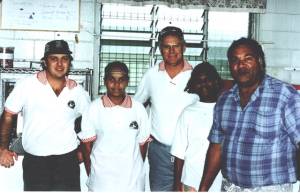 Richard at the Palm Island bakery.
Richard at the Palm Island bakery.
Richard became ill in 2001. Following a diagnosis of pancreatic cancer, he died only six weeks later. A great joy was that he got to hold his daughter's baby. Ilma has since returned to teaching, working with low socioeconomic families to improve their education, living and work prospects. Richard never lost his love of English and was an avid reader and was always writing stories of humorous situations that had occurred during his working days. Sadly, most of these he never retained. Richard loved life and fulfilled his personal mantra to create many and varied memories.
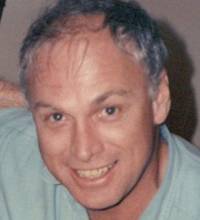 An older Richard.
An older Richard. 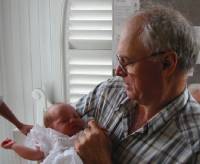 Proud grandfather Richard with one of his four grandchildren.
Proud grandfather Richard with one of his four grandchildren.